Physical Address
304 North Cardinal St.
Dorchester Center, MA 02124
Physical Address
304 North Cardinal St.
Dorchester Center, MA 02124
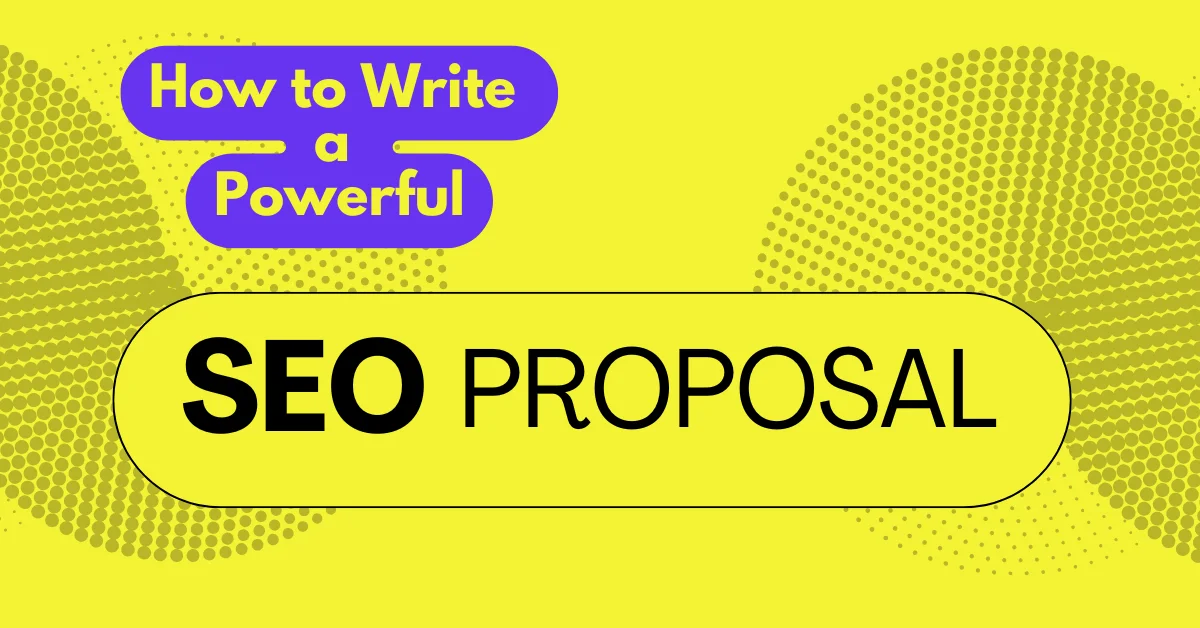
SEO is effective—but while you understand this, your potential clients might not. An SEO proposal helps outline how your services can drive organic traffic and achieve their goals.
This guide will explain the key elements of an SEO proposal and how to create one. It also includes a free, user-friendly template with helpful tips for getting started.
An SEO proposal is a strategic document outlining customized plans to improve a website’s search visibility and performance.
A compelling proposal not only demonstrates your expertise but also differentiates your services from competitors—whether agencies, freelancers, or independent consultants.
The good news? Crafting a winning SEO proposal doesn’t have to be a lengthy process. With our free, ready-to-use template (available at the end of this article), you can effortlessly tailor proposals to meet each client’s specific objectives.
Your SEO proposal should be tailored to each client’s unique needs and objectives. While this guide outlines essential components, feel free to adjust sections as necessary.
The introduction serves as your sales pitch—convincing the client that your agency is the right fit for their SEO needs.
To establish credibility
This section highlights key findings from your preliminary SEO analysis, demonstrating your agency’s understanding of the client’s unique challenges and opportunities.
Rather than conducting a full SEO audit upfront, offer a “light” site audit to provide valuable insights without giving away too much before securing the client.
🔹 Keyword Research & Competitive Gap Analysis
Evaluate the client’s current keyword rankings and compare them to their competitors to identify missed opportunities.
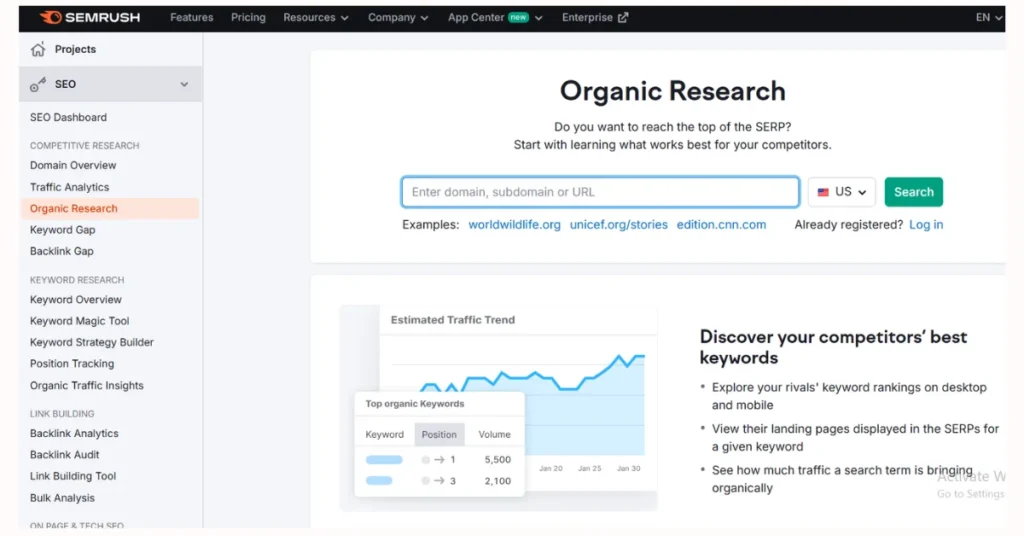
Using a tool like Semrush, you can quickly uncover areas for improvement
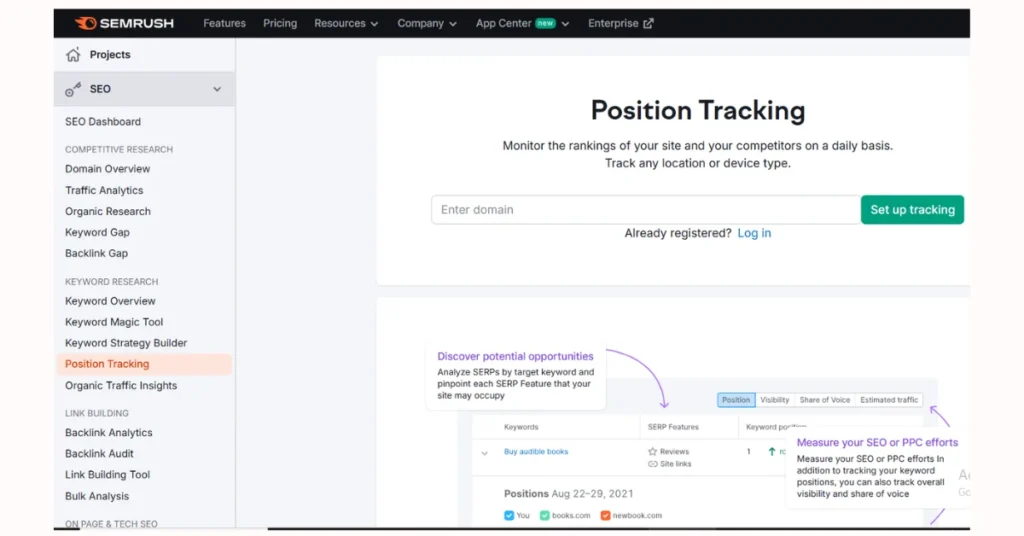
A thorough backlink analysis helps assess both the quality and quantity of external websites linking to the client’s domain. This process is essential for identifying high-value link-building opportunities while flagging any low-quality or toxic links that may harm search rankings.
For a more efficient analysis, utilize Semrush’s Backlink Analytics tool

This tool provides key insights, including
✅ The total number of backlinks and referring domains
✅ Anchor text distribution and its impact on rankings
✅ Authority scores of linking websites
✅ Actionable recommendations for improving the backlink profile
SEO Consultant Christina LeVasseur recommends incorporating an interactive element in initial audits or client training sessions. When clients see firsthand that their page isn’t the most engaging or clickable option, they better understand the value of professional SEO services.
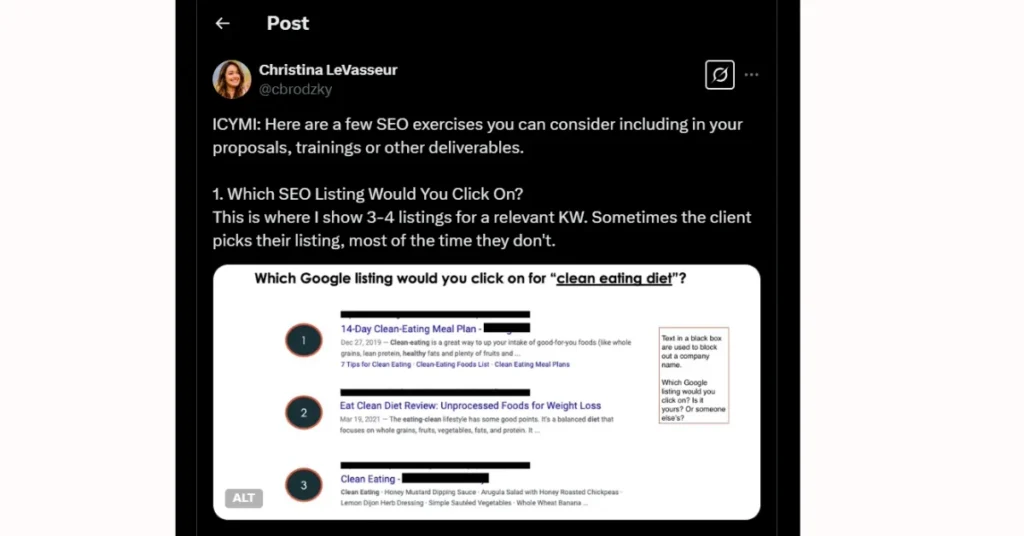
Meanwhile, Trond Lyngbø, founder of Search Planet and senior SEO consultant, suggests analyzing historical sales data and conversion rates to identify high-value opportunities for optimization.
By grounding your recommendations in data-driven insights, you help potential clients make informed business decisions while demonstrating your commitment to their success.
For a deeper dive into on-page analysis, check out our knowledge base guide on advanced SEO auditing techniques.
Conducting a light SEO audit before submitting a proposal allows you to
✅ Personalize recommendations based on actual site performance
✅ Set realistic, achievable goals
✅ Showcase your expertise and strategic thinking
✅ Highlight the potential for measurable SEO success
Using insights from your initial audit, outline customized SEO strategies and complementary services to help the client achieve their goals.
✅ Comprehensive Technical SEO Audit – Optimize site speed, enhance mobile-friendliness, refine URL structures, implement schema markup, and fix crawl errors.
✅ Local SEO Enhancement – For location-based businesses, improve Google My Business listings, strengthen citation building, and develop a review generation strategy.
✅ Content Strategy & Optimization – Identify content gaps, suggest new topics, and refine underperforming pages to align with SEO best practices.
✅ Competitor Analysis & Benchmarking – Assess competitors’ SEO strengths and weaknesses, leveraging insights to create a winning strategy.
✅ SEO Training & Knowledge Sharing – Educate the client’s team on essential SEO principles to ensure long-term success.
✅ Content Creation & Development – Craft high-quality, keyword-rich content designed to engage the audience and drive organic traffic.
For each proposed solution, highlight the measurable benefits, such as higher search rankings, increased organic visibility, improved engagement, and enhanced conversion rates, reinforcing the value of your expertise.
Establishing clear SEO goals ensures focus, direction, and measurable success. Vague objectives like “increase leads” lack the specificity needed to track progress effectively.
To create actionable and results-driven goals, apply the SMART framework
🔹 Specific – Clearly define the objective
🔹 Measurable – Track progress with quantifiable data
🔹 Attainable – Set realistic and achievable targets
🔹 Relevant – Align with the client’s business goals
🔹 Time-bound – Set a deadline for completion
For example, instead of saying “increase website traffic,” a SMART SEO goal would be:
“Boost organic website traffic by 25% within six months through on-page optimization, content creation, and backlink building, as measured by Google Analytics.”
This approach provides a clear benchmark for success and ensures the goal is achievable and trackable.
📈 Organic Traffic – Growth in visitors from search engines
📊 Keyword Rankings – Positioning of target keywords in SERPs
📌 Click-Through Rate (CTR) – Percentage of users clicking on search results
🎯 Conversion Rate – Visitors taking a desired action
📖 Pages per Session – Engagement level of website visitors
👀 Impressions – How often the site appears in search results
⏳ Time on Site – How long visitors stay on a page
🏆 Domain Authority – The site’s credibility and ranking potential
By setting SMART goals, you help clients understand your strategic approach and how each action contributes to measurable, long-term SEO success.
One of the most common client questions is: “How long will it take to see results?” While SEO typically shows measurable improvements within 6 to 12 months, the exact timeline varies based on multiple factors.
For example
📌 Competition – Low-competition niches yield faster results than highly saturated markets.
📌 Resource Allocation – More investment in SEO efforts accelerates progress.
📌 Website History – New domains take longer to rank than established ones.
📌 Technical Health – Poor Core Web Vitals and slow site speed can hinder ranking improvements.
Matt Umbriac, Head of Client Services at First Principles, showcases how SEO efforts over three years led to steady and sustainable growth for a site requiring significant work.
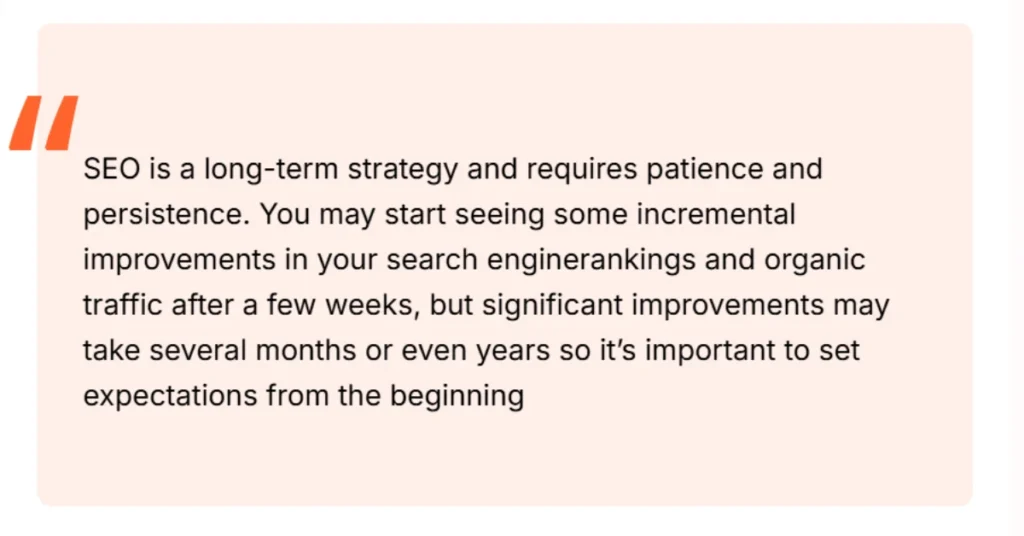
Meanwhile, Josh Pettovello, Senior SEO Data Analyst at KORTX, emphasizes the importance of helping clients embrace SEO as a long-term strategy rather than expecting instant results.
SEO is a marathon, not a sprint. Clearly communicate that success depends on multiple factors, and results may take longer than expected. Setting a transparent, data-backed timeline ensures realistic expectations while reinforcing the long-term value of SEO.
Defining the budget upfront helps set expectations for deliverables and ensures alignment with the client’s goals. Offering tiered pricing allows clients to choose a package that fits their needs and investment level.
🔹 Starter SEO Package – Perfect for small businesses or those new to SEO. Covers essential services like keyword research, fundamental on-page optimizations, and basic link-building.
🔹 Growth SEO Package – Designed for companies ready to scale their SEO efforts. Includes advanced keyword research, content strategy, technical SEO fixes, and strategic link-building.
🔹 Elite SEO Package – Best for businesses looking for an aggressive, high-impact SEO strategy. Offers comprehensive services like international SEO, ecommerce optimization, and advanced analytics tracking.
Providing multiple pricing options empowers clients to select a plan that aligns with their budget while ensuring they receive maximum value from their SEO investment.
A strong Call to Action (CTA) is essential in your SEO proposal, as it directs the potential client on how to proceed. Whether it’s booking a consultation, finalizing a contract, or initiating payment, your CTA should be clear and actionable.
Make it easy for clients to understand their options—whether they’re ready to move forward immediately, revisit the proposal later, or decide not to proceed. A well-defined CTA ensures a smooth decision-making process and encourages prompt action.
A compelling SEO proposal not only helps secure new clients but also sets clear expectations and establishes a strategic plan for success. On the other hand, a poorly structured proposal may fail to showcase your expertise and unique value, potentially costing you valuable opportunities.
Before drafting your proposal, take the time to gather key insights about the client’s business, goals, and pain points. This will allow you to position your services as the ideal solution to their SEO challenges.
Consider asking these essential discovery questions
🔹 What are your primary business objectives, and how do you see SEO contributing to them? (e.g., more leads, higher sales, increased organic traffic)
🔹 Who are your biggest competitors, and how do you compare to them?
🔹 Who is your target audience, and what are their search behaviors?
🔹 What SEO challenges have you faced in the past?
🔹 What SEO efforts have you implemented so far, and what results have they yielded?
🔹 Which keywords do you believe potential customers are using to find your business?
🔹 Are there specific SEO services you’re particularly interested in?
🔹 What is your budget for SEO services?
Using this information, you can craft a Highly Customized Proposal that speaks directly to the client’s needs—demonstrating your expertise, strategic thinking, and commitment to delivering measurable results.
Customizing your SEO proposal helps you differentiate yourself from competitors and shows potential clients that you understand their specific challenges and goals.
According to Semrush’s research on successful agency pitches, 74 out of 100 brands ranked a client-focused strategy as the most critical element in a winning proposal.
Here’s how you can personalize your SEO proposal effectively:
🔹 Conduct Thorough Research – Gain insight into the client’s industry, competitors, and market position. This allows you to tailor your proposal to their strengths, weaknesses, and pain points.
🔹 Align with Their Goals – Use the information you’ve gathered to craft a goal-oriented proposal, showing how your SEO expertise can help them achieve measurable success. Provide case studies or examples of similar clients you’ve helped.
🔹 Speak Their Language – Mirror the terminology and tone used in their marketing materials. This makes your proposal feel more relevant, engaging, and aligned with their brand identity.
🔹 Address Their Concerns – If the client has reservations about SEO, proactively address them. Demonstrate how your strategies can overcome their challenges, using data-backed success stories to build credibility.
By personalizing your proposal, you show potential clients that you’re not offering a one-size-fits-all approach—you’re delivering a strategy tailored to their unique business needs.
Creating multiple proposals from scratch can be time-consuming. Instead, streamline the process by using a customizable template—just fill in the details for each client.
We’ve designed a ready-to-use template (available below) that you can save as a go-to resource for your proposals.
While templates can speed up the process, make sure to personalize each proposal to address your client’s unique challenges, goals, and industry-specific needs.
A well-designed proposal is not just about words—it should be visually appealing to keep clients engaged.
📊 Incorporate Visual Elements – Use charts, graphs, and images to present data and complex ideas in a more digestible format.
🎨 Maintain Brand Consistency – Include your company’s logo, colors, and fonts to create a professional and cohesive look.
🔹 Emphasize Key Points – Draw attention to critical sections by using bold fonts, larger text, or contrasting colors.
Balancing content and design ensures that your SEO proposal is not only informative but also visually compelling—helping you make a lasting impression on potential clients.
Build trust and credibility with potential clients by incorporating case studies, testimonials, and social proof into your proposal.
For example, sharing a case study—like how an SEO agency boosted an artisan bakery’s mobile organic traffic by 460%—demonstrates real-world success and reinforces your expertise.
🔹 Highlight Relevant Case Studies – Choose examples that align with your prospect’s industry or business model to make your success stories more relatable and impactful.
🔹 Leverage Testimonials – Include client feedback that emphasizes the tangible results you’ve delivered.
By providing data-driven proof of your achievements, you show potential clients that you don’t just promise results—you deliver them.
Tip: Before mentioning a past client’s name, obtain their permission to use their testimonial in your proposal.
You can also showcase other forms of social proof, such as industry certifications, awards, or professional recognition.
Include anything that highlights your unique value, helping the client understand why your SEO agency is the best choice.
Easily create compelling SEO proposals with Semrush’s free template, featuring all the key elements discussed in this article and customizable for every client.
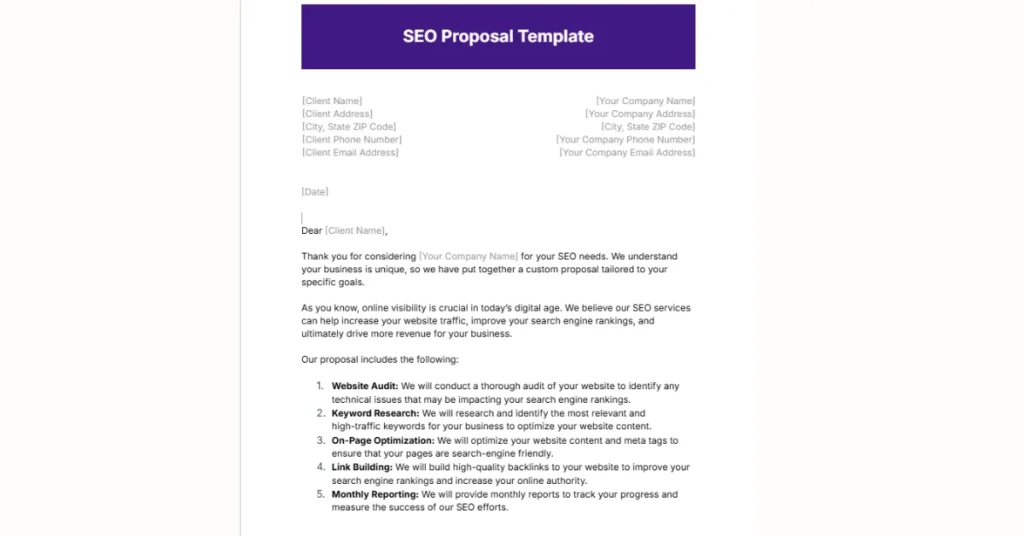
| Download the SEO Proposal Template here.
To maximize the effectiveness of your SEO strategies, tailor each proposal to meet your client’s specific needs and objectives.
A well-crafted proposal not only sets you apart from the competition but also helps build trust with potential clients, increasing your chances of securing long-term business.
Take the time to conduct an in-depth discovery call, uncovering your client’s challenges and goals. Then, present a clear and actionable SEO plan that highlights your expertise and the measurable results you can deliver.
A truly effective proposal goes beyond listing your services—it demonstrates the real value you bring to the client’s business. With a thoughtful, client-focused approach, you can win their confidence and lay the groundwork for a lasting partnership.